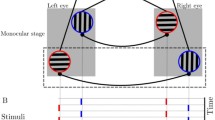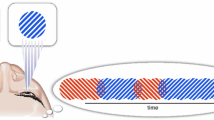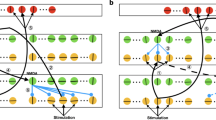Abstract
Binocular rivalry is an interesting phenomenon observed in the human vision. It occurs when the right and left eyes are given different stimuli (pictures). This paper describes a mathematical model which explains the mechanism of binocular rivalry. Our basic assumption is that binocular rivalry is elicited by the mutual inhibition between the right and left visual neuron systems. The mutual inhibition between two neurons is first discussed in detail, where a special emphasis is put on a fatigue effect of neurons, and then its results are applied to a simulation model of binocular rivalry.
Similar content being viewed by others
References
Fox, R., Herrman, J.: Stochastic properties of binocular rivalry alternations. Percept. Psychophys.2, 432–436 (1967)
Harmon, L.D., Lewis, E.R.: Neural modelling. Physiol. Rev.46, 513–591 (1966)
Levelt, W.J.: The alternation process in binocular rivalry. Brit. J. Psychol.57, 225–238 (1966)
Motokawa, K.: Physiology of color and vision, p. 242, Tokyo: Igaku Shoin 1970
Reiss, R.: A theory and simulation of rhythmic behavior due to reciprocal inhibition in nerve nets. Proc. of the 1962 A.F.I.P.S. Spring Joint Computer Conference. National Press21, 171 (1962)
Sansone, G., Conti, R.: Nonlinear differential equations, p. 176. Oxford: Pergamon Press 1964
Author information
Authors and Affiliations
Rights and permissions
About this article
Cite this article
Matsuoka, K. The dynamic model of binocular rivalry. Biol. Cybern. 49, 201–208 (1984). https://doi.org/10.1007/BF00334466
Received:
Issue Date:
DOI: https://doi.org/10.1007/BF00334466




